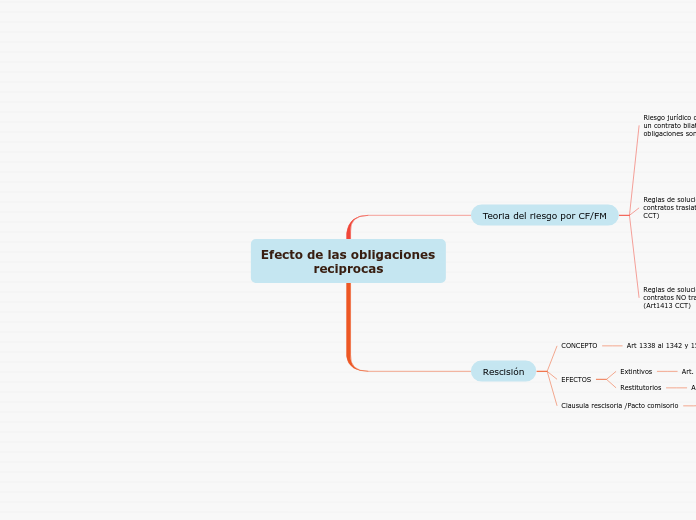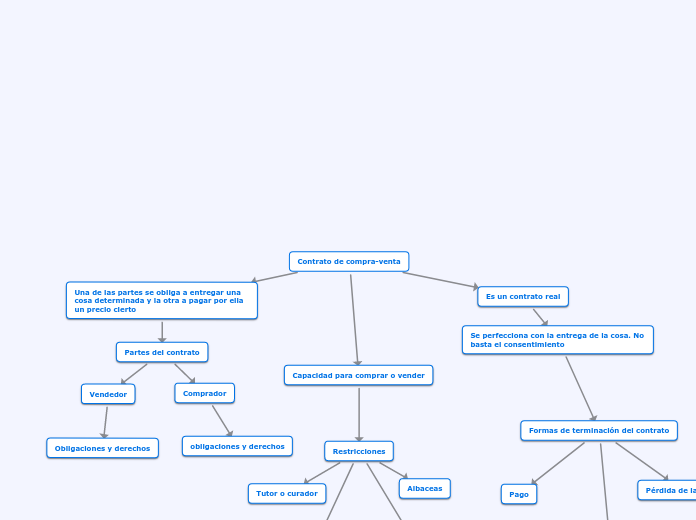Efecto de las obligaciones reciprocas
To name your story, you have to think about the overall message and what you want your audience to understand from the story. Also, make it relevant and easy to remember.
Rescisión
The middle of the story is where you add layers of complications that will lead to the end. Reveal more about the character's journey. Did their personality go through changes? How did they overcome the challenges? And as you build up the story’s central conflict, make it more personal to that character. Also, from the middle act, you have to lead into the final act.
Clausula rescisoria /Pacto comisorio
There wouldn't be any tension and excitement in your story if there weren't any obstacles in your character's way.
Arts. 1340 al 1342 del CCT incluyendo la prescripción.
A story is nothing more than a character overcoming a series of difficulties to reach the desired goal. Obstacles usually create suspense and conflict. In overcoming obstacles, there is growth: weak becomes strong; hatred turns into love; sadness into happiness; wrong into right; lies into truth; or evil becomes good.
See a few examples below:
- stopping a meteor
- finding a killer
- finding love
EFECTOS
Your character(s) need(s) motivation in order to solve the challenge(s).
Restitutorios
Secondary characters might also have motives that lead them to cross paths with the main character or which might trigger them to help the main character.
Arts. 1340, 1269, 1267 del CCT
Extintivos
Why does your character need to confront this challenge? What does he/she expect to accomplish by solving it?
See a few examples:
- will marry in 3 days
- can fix the mistakes of the past
Art. 1340 del CCT
CONCEPTO
Each story has a main character and that character usually needs to solve a problem or challenge. The character's challenge is the one that creates tension throughout the story.
Art 1338 al 1342 y 1537 del CCT
In most stories, there are 3 challenges. The number 3 is a mystical number symbolizing completeness. Try to come up with interesting challenges with which your character needs to struggle.
See a few examples below:
- turns into a werewolf at night
- is sent back in time
Es la resolución de un contrato bilateral,
plenamente válido a causa del incumplimiento
culpable de una de las partes.
Teoria del riesgo por CF/FM
In the beginning of the story (or the exposition), you will need to introduce the setting and characters. You might also want to introduce the main conflict. This part of the story is important because it gives the reader necessary background information and maybe even a first insight into a character’s personality.
Reglas de solución ante el incumplimiento de contratos NO traslativos de dominio por CF/FM (Art1413 CCT)
NADIE ESTA OBLIGADO A LO IMPOSIBLE
The time of the story can also change. It can describe the event of a single day or can include an entire year's plot. Anyway, don't forget to mention it.
Por vía de CF/FM se liberan de su obligación tanto el acreedor como el deudor y viceversa en la dualidad que se maneja, y ambas partes soportan el daño (gastos) además que dando como resultado de esto la extinción del contrato.
Sensory details include sight, sound, touch, smell, and taste. These details are important because they create depth in your setting.
See a few examples below:
- the smell of fresh bread
- the scent of freshly cut grass
- rain falling onto the windshield etc.
Reglas de solución ante el incumplimiento de contratos traslativos de dominio por CF/FM (Art.1413 CCT)
The setting (time & place) of a story can change throughout the plot.
Por vía de CF/FM se liberan de su obligación tanto el acreedor como el deudor y viceversa en la dualidad que se maneja, pero solo corre el riesgo y soporta la perdida o demerito sobre la coa el dueño.
Your story can take place wherever your imagination will take you to.
For example: in an elevator, in an enchanted forest, etc. Don't forget to give details of the environment each time the setting changes, otherwise, the story can be confusing. Also, mention the seasons as each of them has unique weather and events.
¨DUEÑO¨ hablando de cosas genéricas
Art.1524, 1560 La transmisión de dominio sobre cosas genéricas, hacen de nuevo dueño al adquiriente hasta que las cosas genéricas se hacen ciertas y determinadas, el enajenante del producto sigue siendo dueño y por tanto soporta la perdida.
Ejemplo de cosa genérica
Ej.: compraventa de naranjas. Tienen importancia respecto de los riesgos por pérdida de la cosa, ya que, hasta que no se especifiquen las cosas objeto de dicha obligación, la imposibilidad de cumplimiento por pérdida recae sobre el deudor, por entenderse que el género nunca perece.
Fuente
http://www.enciclopedia-juridica.com/d/obligaciones-gen%C3%A9ricas/obligaciones-gen%C3%A9ricas.htm
¨DUEÑO¨ hablando de cosas especificas
Art.1511, 1560. La transmición de dominio sibre cosa cierta y determinada hacen dueño de inmediato al adquiriente aun que no haya recibido la cosa ni hecho el pago y ademas configurandose como dueño en automatico el soporta el riesgo de la perdida.
Type in the name of your character.
Ejemplo y concepto de cosa determinada.
Time of plot
El legado de cosa cierta es el que tiene un objeto material cierto y determinado; por ejemplo, mi reloj, mi biblioteca, mi casa habitación, mi estancia
Fuente:http://www.enciclopedia-juridica.com/d/legado-de-cosa-cierta/legado-de-cosa-cierta.htm#:~:text=El%20legado%20de%20cosa%20cierta,mi%20casa%20habitaci%C3%B3n%2C%20mi%20estancia.&text=Es%20el%20legado%20t%C3%ADpico%2C%20el,desde%20la%20muerte%20del%20testador.
Riesgo jurídico que se produce en la celebración de un contrato bilateral en el que los derechos y obligaciones son reciprocas
Characters are essential to a good story. Usually, the protagonist(s) is/are the most affected by the plot. Introduce a character by focusing on their actions, interests, and occupation, as the physical appearance doesn't make a difference in most cases.










